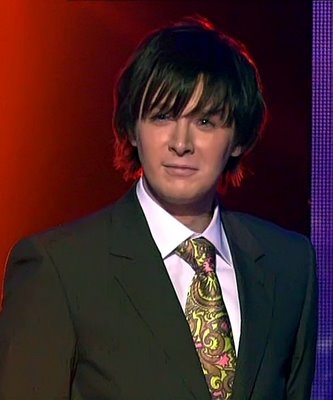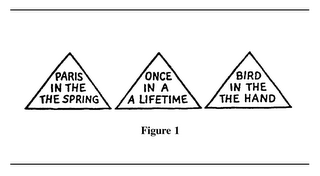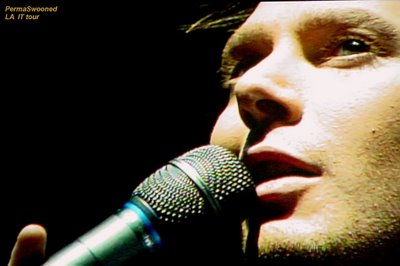Why am I thinking about perception this week? Because this week gave us the culmination of this season's American Idol reality show. Unless you have been living in a cave, most of you are probably aware that Taylor Hicks (http://taylorhicks2006.com/) defeated Katherine McPhee (http://katharinefans.com/) to take the crown as the fifth American Idol.
The show was a star-studded affair with many celebrities in the audience and performances by Al Jarreau, the band Live, Mary J. Blige, Meat Loaf, Toni Braxton, Burt Bachrach, Dionne Warwick, and PRINCE !!! The show's host estimated that 200 million people world-wide were watching the broadcast. It was quite a night.
Naturally, the stories about the show have dominated the media for the past several days. However, the most popular story which is being discussed over and over does not involve the winner or any of the high-wattage stars who appeared. It revolves around a young man, Michael Sandecki, who appeared on the show as one of the "bad auditions". His "shtick" for his audition was that he was going to be the next Clay Aiken.
 Unfortunately for Michael, singing is not really his forte. On Wednesday night they presented Michael with an "award" as "Best Celebrity Impersonator". After presenting him with his "trophy", he was asked to sing for the audience. Michael was more than happy to oblige, and launched into a very painful version of "Don't Let The Sun Go Down On Me"; the song that earned Clay Aiken the Wild Card slot as America's Choice three years ago on American Idol 2.
Unfortunately for Michael, singing is not really his forte. On Wednesday night they presented Michael with an "award" as "Best Celebrity Impersonator". After presenting him with his "trophy", he was asked to sing for the audience. Michael was more than happy to oblige, and launched into a very painful version of "Don't Let The Sun Go Down On Me"; the song that earned Clay Aiken the Wild Card slot as America's Choice three years ago on American Idol 2.To Michael's complete astonishment and utter delight, the curtain behind him opened while he was singing and who should stride out and start singing but Clay Aiken himself. It was a great moment. Michael's shock and joy was so evident, it was impossible not to smile at his reaction at the chance to sing with his "Idol". Clay was so gracious, extending Michael's time in the spotlight, and obviously getting a big kick out of the whole thing. Plus, he reminded everyone that he has one of the best voices of his generation, making it not just a great humerous moment, but a great musical moment as well. And, of course, he looked every inch the star.
Clay had a great storyline on the show. He was studying to become a special education teacher. He wanted to start a foundation for kids with disabilities. At 6'1" and 145 lbs., he was the perfect "David" for Ruben Studdard's 6'4" 400+ lbs. "Goliath". He was the skinny geek with the big voice.

A great deal has been made of Clay Aiken's "makeover" on American Idol. There have been a zillion articles with a "geek to chic" theme.
Let's get real. He got contact lenses. I think they tamed his eyebrows a bit. They highlighted his hair and gave him a spiky style to help hide his rather prominent ears. Ummmm. That's it!!!
Whether he loved it or hated it, that hairdo became a trademark. If any of you can find 5 articles about him that don't include the descriptive "spiky-haired" in the text, you are better researchers than I.

That image was reinforced over and over. The last time Clay performed on American Idol was on the Top 4 show two years ago. We got a "hybrid" Clay on that show. We got the audition glasses AND the highlights and spikes. Something for everyone.
On this year's finale show, nearly everyone but Michael Sandecki was expecting Clay Aiken to step out on that stage. Everyone knew exactly what to expect. However, Clay had something else planned for the occasion. A few months ago, Clay sent a message to his fan club telling them to "open their minds and expect something different". It seemed clear that he was talking about his forthcoming album. Or maybe not. Because THIS is the person who stepped out on that Idol stage.
 This has been a pretty big week in the news, and yet what is the burning question that is being asked in poll after poll, interview after interview and article after article? The question is: "What do you think of Clay's HAIR???"
This has been a pretty big week in the news, and yet what is the burning question that is being asked in poll after poll, interview after interview and article after article? The question is: "What do you think of Clay's HAIR???"Taylor Hicks and Prince must be wondering what on earth is going on!! One would think that an unprecedented appearance by a music legend and actually winning the contest would be more newsworthy than Clay's new hairstyle. One might think that, but one would be wrong.
This drastic change in hairstyle has forced many people to take a new look at Clay, because he wasn't what they expected. Many people saw him as bigger, more handsome, and dare we say....HOT!!!
One of my favorite quotes came from Leslie Gray Streeter at the
Palm Beach Post:
"That fake Clay kid who couldn't sing even after a second chance is singing "Don't Let The Sun Go Down On Me." Who's that behind him...Clay Aiken!!! He's almost hot. Did you hear that, Claymates? I said he was hot! Did you hear me? Are you happy now?"
Yup. Welcome to the club, Leslie!!
How is it possible that a new hairstyle can cause so many people to "see" Clay Aiken with fresh eyes? He has a new haircut and color. He is 3 1/2 years older. He has (thankfully) filled out his previously skinny frame. He has the confidence that only sales of 4 million albums, 1.5 million singles and six concert tours in 3 years can bring. That's about it. As Clay himself has said, "the wrapping is different, but the gift inside is the same". Well, we're back to perception again.
I was so fascinated by this whole phenomenon, I went looking for some professional input. The most interesting thing I found was a book called The Psychology of Intelligence Analysis by Richards J. Hueur, Jr. It is a training manual used to teach observational skills by the C.I.A.!!
Chapter 2 is titled: "Perception: Why Can't We See What Is There To Be Seen?" The author states that what people perceive is strongly influenced by their past experiences, education, cultural values, and role requirements, as well as by the actual stimuli recorded by their senses. He makes several points regarding perception.
1. We tend to perceive what we expect to perceive.
We are conditioned by our experiences to anticpate when presented with new stimuli. The author shows the following example to demonstrate this point. Take a look at the following illustration:

The triangles contain 3 little homilies that are very familiar to most people who see them. So how many of you realized right away that each triangle repeats the "article" in the saying (the/the, an/an/, the/the)? I sure didn't see that. I saw what my prior experiences caused me to expect.
2. Mind-sets tend to be quick to form but resistant to change.
This principle emphasizes why "first impressions" are so important. Once that impression is formed, it is going to be very difficult to change. Remember that on your next job interview!! Try this next little test:
 Researchers found that if someone was shown only the picture on the upper right, they tended to see a woman kneeling. However, if they saw the whole series, it depended on where they started. If they started on the upper left, the image of a man's face persisted until the last 3 images. It worked the same way if they started with the woman's image and worked through the pictures in the opposite direction. As it says in the drawing, impressions resist change. To paraphrase Mr. Hueuer, once someone has formed a mind-set or expectation for something they are observing, that mind-set will color all future perceptions of that same object...or person.
Researchers found that if someone was shown only the picture on the upper right, they tended to see a woman kneeling. However, if they saw the whole series, it depended on where they started. If they started on the upper left, the image of a man's face persisted until the last 3 images. It worked the same way if they started with the woman's image and worked through the pictures in the opposite direction. As it says in the drawing, impressions resist change. To paraphrase Mr. Hueuer, once someone has formed a mind-set or expectation for something they are observing, that mind-set will color all future perceptions of that same object...or person.
3. New information is assimilated to existing images.
This principle explains why gradual changes frequently go unnoticed. Have you ever had the experience of working on a puzzle or perhaps trying to assemble one of those frustrating pieces of Ikea furniture and getting "stuck" somewhere along the way? Then someone else comes in and immediately fits in the missing piece, or points out the error in your assembly process. Maddening, isn't it? Clinging to your first impression even as the project evolves can lead you in the wrong direction. How long do you stick to your original impression, and how slow are you to see other possibilities? Try this last example. What do you see in this picture?
 The picture is of a woman, but do you see a young woman or an old woman? Most people will immediately form an impression of one or the other. Whichever woman you see, how long did it take you to see the other woman? Still working on it? The young woman has a smaller face and is looking away from us. The older woman has a larger face and is turned a bit more in our direction. It can take quite a while to make the shift from one image to the other even after you can see both of them. We assimilate the details into our previous impression, such as interpreting the older woman's mouth as the younger woman's necklace. Interesting, isn't it?
The picture is of a woman, but do you see a young woman or an old woman? Most people will immediately form an impression of one or the other. Whichever woman you see, how long did it take you to see the other woman? Still working on it? The young woman has a smaller face and is looking away from us. The older woman has a larger face and is turned a bit more in our direction. It can take quite a while to make the shift from one image to the other even after you can see both of them. We assimilate the details into our previous impression, such as interpreting the older woman's mouth as the younger woman's necklace. Interesting, isn't it?4. Initial exposure to blurred or ambiguous stimuli interferes with accurate perception even after more and better information becomes available.
What this means is that people will cling to a vague impression of something for quite a while, even when they get more data to clarify the picture. Experiments have shown that someone can be shown a blurry picture of something very familiar, like a dog, and it will take a long time to identify it, even as the picture becomes more focused. It also seems that the blurrier the original picture, the longer the process will take. Mr. Hueuer points out that people will cling to their original perception, incoporating new infromation into that image "until the contradiction becomes so obvious that it forces itself upon our consciousness". Sort of like this:


BLAM!!! Clay blasted those previous perceptions to smithereens!! Hey, if you are going to introduce a new look, you might as well hit 200 million people all at once.
The range of reactions has been amazing. From "I LOVE IT!!" to "Who is that guy and what has he done with MY Clay!!" to the hilarious "Hmmm...Clay looks good! He must have gotten a nose job/dental veneers/cheek implants/chin implants or be on steroids". HA!!! Some people are definitely more resistant to changing their perceptions than others!!
OK people, I'm going to help you out here. It's all about the bone structure. In case there actually is such a thing as reincarnation, I already have my request in for Clay Aiken's cheekbones in my next life. Seriously, he has always had those cheekbones, a nice straight nose, beautiful eyes and a great smile. It makes it a joy to take pictures of him in concert, when the passion he feels while singing is reflected in his face and his whole being.
For those who are struggling with the transition, I am providing these pictures taken at concerts I attended between August 2003 and December 2005 as visual aids:







Does that help? Be sure and catch Clay in person on his next concert tour. Trust me, you won't have any trouble perceiving him more accurately, and you will be incredibly entertained to boot.
An incredibly talented fan put together the following montage of the four times Clay Aiken has sung "Don't Let The Sun Go Down On Me" on American Idol. The first two clips are from the Wild Card performance and results shows in March 2003. The third clip is from the Final 2 Special in May 2003. The last one is from his AI5 appearance in May 2006. You will notice that in addition to the new look, he has changed the key of the song to make it a bit lower. Another sign that the geeky late-bloomer has been busy maturing over the past 3+ years. Check it out.
Although I am not always a big fan of change, I have no problem with Clay's new "wrapping" because I know that "the gift inside is the same". He still has that great voice. He still has that great heart. He still has that great sense of humor. Works for me. I'm ready for whatever new surprises are in store.
Bring it on, Clay!!!
For a great compilation of reactions of Clay's appearance on American idol, vist idle-wandering
For some amazing high definition visuals of the performance, check out The Clay Blog
Related Tags: Clay Aiken, American Idol, Taylor Hicks, Katherine McPhee, perception, Richards J. Hueuer Jr, C.I.A.










